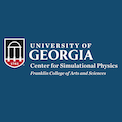Events Calendar View
-
CSP Lunch Seminar
Oct 27, 2015
Polymer Adsorption on a Honeycomb-Patterned Surface: Characterization of Structural Phases by Means of Suitable Order Parameters

Guest: Benjamin Liewehr, Center for Simulational Physics, University of Georgia
Tuesday, October 27, 2015 12:30 pm - 1:30 pm
Location: CSP Conference Room (322) -
CSP Lunch Seminar
Nov 3, 2015
Spin Dynamics Simulation of Nanoscale Classical Heisenberg Antiferromagnets
-
Workshop
Nov 14, 2015
Computational Statistical Physics of Condensed Matter Systems

Guest: Soft Matter Systems Research Group, UGA Center for Simulational Physics
Saturday, November 14, 2015 8:45 am - 6:00 pm
Location: CSP Conference Room (322)The workshop will cover various theoretical and computational topics in condensed matter physics such as structural transitions of polymers and spin dynamics, as well as statistical data analysis methods.
The schedule of the workshop is as follows
8:45am Welcome
9:00-12:30am Session 1 and 2 (two 45mins talks each)
12:30-2:30pm lunch break
2:30-6:00pm Session 3 and 4 (two 45mins talks each)
6:00pm Closing
Everybody is welcome to attend!
-
CSP Lunch Seminar
Nov 17, 2015
Spin Wave Excitations of α-Iron in Strong Magnetic Fields: An MDSD Study

Guest: Mark Mudrick, UGA Center for Simulational Physics
Tuesday, November 17, 2015 12:30 pm - 1:30 pm
Location: CSP Conference Room (322) -
Departmental Colloquium
Nov 19, 2015
The Quenching of CO: The Complex Story of an Almost Homonuclear Molecule

Guest: Professor Phillip Stancil, UGA Physics and Astronomy
Thursday, November 19, 2015 3:30 pm - 4:30 pm
Location: Physics Auditorium (202)Carbon monoxide (CO) is detected in nearly every astronomical source from comets to high redshift quasars. It is observed in absorption in the UV, and by emission due to rotational and vibrational transitions from the near IR to submillimeter wavelengths. In most environments, CO rovibrational levels have populations far from thermal equilibrium so that the populations are determined primarily by collisions with dominant neutral species (H2, He, H). While collisional excitation of CO has been studied theoretically and experimentally for many decades, it may seem surprising that large uncertainties, orders of magnitude in some cases, remained in our knowledge of key parameters until now. It is only in recent years that computational resources and algorithms have advanced sufficiently that nearly exact, full-dimensional calculations have become feasible. In this talk I will highlight our recent computational work on full-dimensional scattering calculations, focusing on the CO-H, CO-H2, and CO-He collision complexes for rotational and vibrational excitation. I will also discuss the role of collisional data in astrophysical modeling. -
CSP Lunch Seminar
Jan 19, 2016
Feeding and feedback in the multi-phase interstellar medium
The interstellar medium is the intermediary between star formation, stellar feedback, and galaxy evolution. Our understanding of the ISM has evolved from a static three-phase model into one in which turbulence and magnetic fields regulate a much more complex, dynamic medium. I will present magnetohydrodynamic simulations of this turbulent, multi-phase ISM, demonstrating the dynamic nature of the interaction between the star-forming disk and the Galactic halo. I will also discuss the implications for infall of gas into the Galaxy which feeds future star formation.
Page 62 of 121, showing 6 records out of 723 total, starting on record 367, ending on 372

